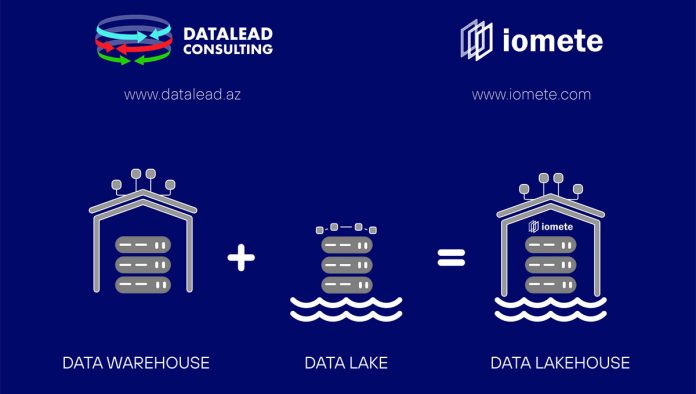The new open architecture of Lakehouse, which combines the best elements of Data Lake and Data Warehouse, has been actively attracting the attention of businesses in recent years. This hybrid solution not only provides the flexibility and scalability of Data Lakes, but also focuses on strict Data Governance, including clear separation of access levels and built-in security mechanisms for reliable storage and processing of information within the concept of classic enterprise data warehouses. While Data Lakes are already widely used by businesses in Azerbaijan for processing large volumes of data and subsequent analytics, the Data Lakehouse concept is just beginning to spread.
To better understand the benefits of this approach, we talked to Ruslan Mammadov, CEO of DataLead Consulting, which is actively promoting the Data Lakehouse solution by IOMETE.
— Why did your company decide to focus on such a direction as Data Lakehouse?
— Let’s start with the fact that Data Lakehouse is not the only area of our company’s activity. Our company started its activity by providing services for servicing such traditional database management systems (DBMS) as Oracle, MS-SQL and PostgreSQL, for which our team has the highest level of certification, including Oracle Certified Master, EDB Certified Professional, etc. We also historically work with NoSQL solutions such as MongoDB, Cassandra and HBase. We have implemented many successful projects in government agencies, banking and other areas of business. More than 20 years of experience allows our team to provide prompt and, most importantly, guaranteed high-quality service. At the same time, in recent years, there have been significant changes in business requirements for working with data. Data volumes are growing exponentially and traditional data storage systems can no longer always cope with modern tasks. The emerging need to store and process such types of unstructured data as images, videos and documents of modern business applications, information from social networks and a huge volume of telemetry from various devices (including IoT devices) has led to the emergence and development of Data Lake solutions, which have been actively used by businesses over the past decade. But currently, existing data lake solutions do not provide businesses with sufficiently guaranteed mechanisms for secure access, processing and storage of data. That is why the next evolutionary stage of data lake development is Data Lakehouse technology — a hybrid architecture that combines the best elements of Data Lakes and Data Warehouses, allowing not only to securely store and process large volumes of data, but also to effectively manage them.
— What is the fundamental difference between Data Lakehouse and traditional data storage systems and Data Lake solutions?
— In order to evaluate the advantages of Data Lakehouse, it is necessary to compare it with both approaches at once — Data Warehouse and Data Lake.
A traditional data warehouse (Data Warehouse) is a solution for storing structured data that is pre-processed before loading. After loading, the data becomes available for verification, analysis and other purposes. This is a highly efficient solution that ensures data standardization and consistency. However, there are also disadvantages. Data Warehouse does not take into account raw data that remains outside of it, which limits the ability to analyze and process it. In addition, the time and cost of pre-processing (structuring) and entering information into Data Warehouse databases can increase significantly as the volume of data increases. Indexing and extracting metadata from attached external files, as well as monitoring their relevance and reliability (versioning) significantly increases data processing time and hardware requirements in the DWH paradigm.
Data Lake, on the other hand, can store structured and unstructured data in its original form. This centralized storage can receive data in real time, which allows companies to conduct deep analytics and use various machine learning algorithms. But data lakes also have their weaknesses. One of the key issues is Data Governance. Data Lakes often lack clear mechanisms for data quality control, access control, and protection. An unmanaged data lake risks turning into a so-called «data swamp», where unstructured and poorly organized data becomes useless. Additionally, a lack of attention to data security can lead to serious risks, especially for organizations operating in regulated industries.
The Data Lakehouse architecture is an evolution of the Data Lake, designed to address key data management shortcomings in traditional data lakes. It combines the scalability and flexibility of the Data Lake with the manageability and high query performance of the Data Warehouse. Data Lakehouse can store data in its raw form, like a Data Lake, but it also supports the transactions and metadata management for structured analytics that are typical of the Data Warehouse.
Data Lakehouse improves Data Governance mechanisms, including data quality control, access control, metadata usage, and support for ACID transactions. It combines the flexibility and scalability of the Data Lake with the functionality and structured approach of the Data Warehouse, resulting in more efficient and secure data management. These improvements make Data Lakehouse an ideal choice for organizations working with large volumes of data, where reliability, security, and manageability are important.
Data Lakehouse offers a single management system and storage for all data types, and provides metadata management, ACID transactions, and scalability. The Lakehouse architecture enables organizations to work effectively with data, balancing the flexibility of a Data Lake with the manageability of a Data Warehouse. In addition, the IOMETE Data Lakehouse platform offered by our company supports a wide range of data processing tools such as Python, R, SQL, Scala, Java and others, making it ideal for machine learning and advanced analytics.
— What are the key business benefits of using IOMETE’s Data Lakehouse — Self-Hosted Data Lakehouse Platform?
— Key benefits of Data Lakehouse include:
- Support for various workloads: IOMETE Data Lakehouse can process both structured and unstructured data, allows you to perform both analytical (OLAP) and operational (OLTP) queries, making it flexible for advanced analytics and machine learning tasks.
- Cost-effectiveness: IOMETE’s decoupled compute & storage architecture allows companies to flexibly expand compute or storage resources separately and pay only for the resources they use, significantly reducing costs compared to DWH and DataLake (based on coupled nodes).
- Security and data management: Unlike data lakes, IOMETE Data Lakehouse has built-in security mechanisms that allow you to manage the separation of user access at different levels in a corporate environment and a high level of data protection. Built-in data management tools help control data quality and prevent duplication and poor data quality, which is typical for data lakes.
- Since IOMETE Self-Hosted Data Lakehouse Platform is an umbrella for administering and automating requests for a whole range of Open Source solutions such as Apache Iceberg, Apache Spark, MinIO, Kubernetes, parquet and others, IOMETE customer data department specialists will continue to work in a familiar and already configured environment, even if the customer decides not to renew their IOMETE subscription. They will still have a fully installed and configured Open Source product suite. This gives companies confidence that their data will remain under control, and the tools they use will not become dependent on subscriptions and license agreements for specific software from one vendor.
— What tasks does IOMETE Data Lakehouse solve?
— Data Lakehouse allows companies to easily manage data and use it for reporting, analytics and supporting artificial intelligence. The solution architecture provides businesses with a full cycle of data storage and management:
- Unified data storage and processing: Traditional data warehouses process structured data, while data lakes process unstructured data. The Lakehouse architecture combines both types of data on a single platform, simplifying data analysis and processing.
- Overcoming the limitations of traditional data warehouses: Lakehouse maintains the speed and performance of data warehouses while providing the scalability and flexibility of data lakes, which optimizes storage and fast data processing.
- Integration of stream and batch data processing: The architecture supports both stream and batch processing on a single platform, providing organizations with dynamic and flexible data processing capabilities.
- Unified platform for analytics and AI: The Lakehouse architecture unifies the storage and processing of all types of data, which makes it easy to apply machine learning (ML) and AI models to data without the need for complex integration or moving data between systems.
— What are the challenges of migrating to Data Lakehouse?
— Although Data Lakehouse has many advantages, its implementation requires qualified specialists who can set up the architecture and, if necessary, migrate data (Data Engineering) and train the customer’s team. Without this support, a successful transition to this solution may take longer. At DataLead Consulting, we are actively developing expertise in the field of Data Lakehouse, helping our clients successfully solve the problems associated with the transition to a new architecture.
— Why do companies choose Data Lakehouse?
— For modern Insight Driven companies working with big data and analytical tasks, Data Lakehouse provides a wide range of tools for working with data, supporting all stages from data acquisition to its analysis, and also helps organizations significantly reduce data storage costs, increase their scalability and simplify data management.
It is worth noting that such a significant corporation for the IT market as Dell Technologies has chosen IOMETE Self-Hosted Data Lakehouse Platform to implement its data management needs and, having successfully completed the initial implementation stage, continues to expand the use of the platform. The company is gradually migrating data from an increasing number of departments that were not initially planned for inclusion in the project, which indicates growing confidence in the IOMETE solution and its effectiveness in supporting the work of various departments.









